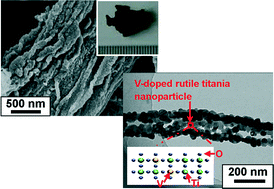Nanofibrous vanadium-doped rutile titania derived from cellulose substance by flame synthesis†
Abstract
Hierarchical vanadium-doped rutile titania materials with well-defined nanofibrous structures were fabricated by flame burning of titania–vanadia composite thin gel films pre-coated natural cellulose substances (e.g., commercial filter paper). Through the facile way of rapid flame burning, the V-doped rutile titania nanofibres composed of nanoparticles with relatively small and uniform sizes were obtained. The diameters of the nanoparticles were effectively controlled to be 15 nm in average, resulting from the suppression of the crystal growth and the phase separation of titania and vanadia in the process of flame burning. By comparison with the V-doped rutile titania materials prepared by calcination treatment, high doping level of vanadium into titania crystal lattices was achieved by means of flame burning. No obvious photocatalytic activity of the synthesized V-doped rutile titania nanofibrous materials was observed for degradation of methylene blue. The doped vanadium atoms substitute Ti4+ in the rutile titania crystal lattices, which serve as electron-hole recombination centers that decrease the photocatalytic activity of the hybrid.


 Please wait while we load your content...
Please wait while we load your content...